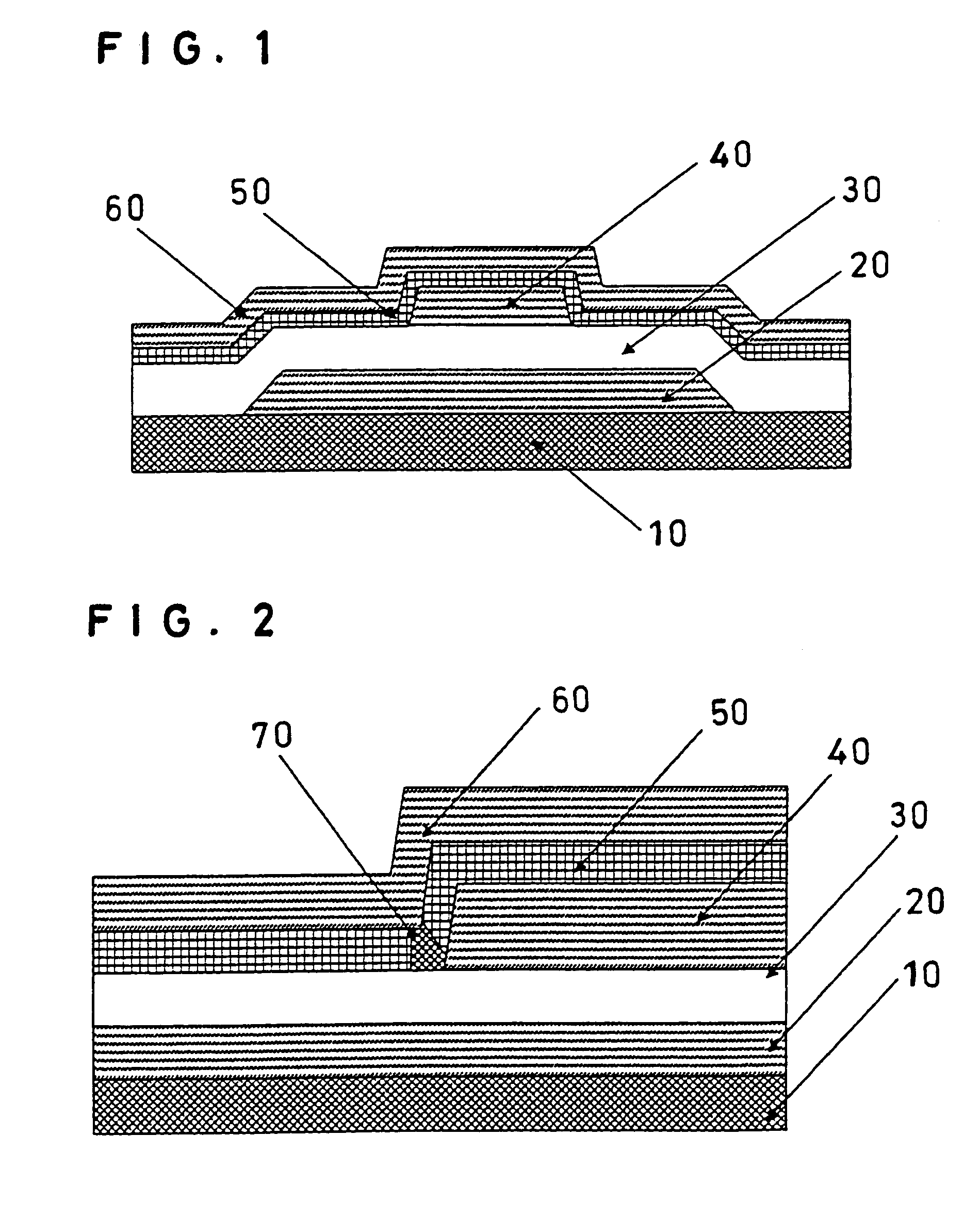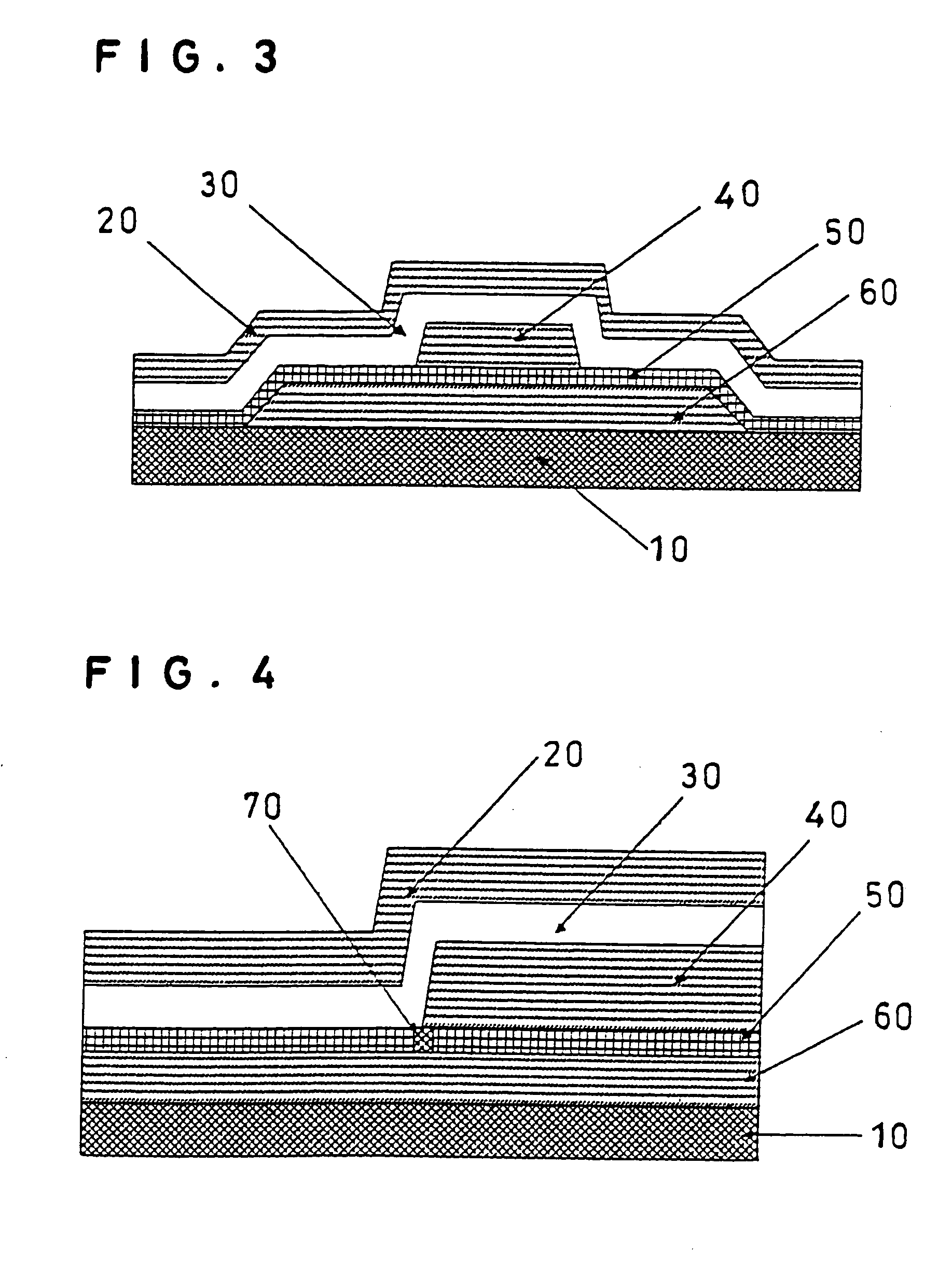Organic thin-film transistor and method of manufacturing the same
a thin-film transistor and organic technology, applied in transistors, solid-state devices, thermoelectric devices, etc., can solve the problems of unsuitable mass-production, difficult to obtain a short source-drain distance of or below 10 m, and a superior technique has yet to be established, and achieves short channel length, easy manufacturing, and good control
- Summary
- Abstract
- Description
- Claims
- Application Information
AI Technical Summary
Benefits of technology
Problems solved by technology
Method used
Image
Examples
example 1
[0096]A substrate (area: 20×35 mm, thickness: 1.0 mm) of synthetic quartz (ES grade) was subjected to 20 minutes of ultrasonic washing with a neutral detergent (PureSoft produced by Iuchi Seieidou Co.) diluted five-fold with pure water, followed by 20 minutes of ultrasonic washing in pure water to remove the detergent. An ultraviolet light-ozone washing device was then used to wash the substrate for 20 minutes by irradiating it with ultraviolet light in an oxygen atmosphere. A nickel mask was then utilized to vacuum-deposit gold onto the quartz substrate thus washed to form a gate electrode 20 that was 100-μm wide and 0.2-μm thick. The film formation conditions at this time were a deposition rate of 6 nm a minute with the substrate at 30° C. Next, as shown in FIG. 12, polymethyl methacrylate (PMMA) was dissolved in chloroform and the solution was used to form on the top of the gate electrode 20 the insulation layer 30 as a layer 0.4-μm thick, using the spin-coating method. Then, as ...
example 2
[0097]An n-type silicon substrate (area: 20×35 mm, thickness: 1.0 mm) on which a 300-nm thermally oxidized silicon film was grown to form an insulation layer 30, was subjected to 20 minutes of ultrasonic washing with a neutral detergent (PureSoft produced by Iuchi Seieidou Co.) diluted five-fold with pure water, followed by 20 minutes of ultrasonic washing in pure water to remove the detergent. An ultraviolet light-ozone washing device was then used to wash the substrate for 20 minutes by irradiating it with ultraviolet light in an oxygen atmosphere. A nickel mask was then utilized to vacuum-deposit onto the substrate thus washed, a gold drain 40 that was 100-μm wide and 0.2-μm thick. The film formation conditions at this time were a deposition rate of 6 nm a minute at a substrate temperature of 30° C. On the top thereof, for the semiconductor layer 50, the vacuum-deposition method was used to form a pentacene thin-film. Refined pentacene was used that had been sublimation-refined t...
example 3
[0098]An n-type silicon substrate (area: 20×35 mm, thickness: 1.0 mm) on which a 300-nm thermally oxidized silicon film was grown to form an insulation layer 30, was subjected to 20 minutes of ultrasonic washing with a neutral detergent (PureSoft produced by Iuchi Seieidou Co.) diluted five-fold with pure water, followed by 20 minutes of ultrasonic washing in pure water to remove the detergent. An ultraviolet light-ozone washing device was then used to wash the substrate for 20 minutes by irradiating it with ultraviolet light in an oxygen atmosphere. A nickel mask was then utilized to vacuum-deposit onto the substrate thus washed, a gold drain 40 that was 100-μm wide and 0.2-μm thick. The film formation conditions at this time were a deposition rate of 6 nm a minute at a substrate temperature of 30° C. On the top thereof, for the semiconductor layer 50, the vacuum-deposition method was used to form a pentacene thin-film. Refined pentacene was used that had been sublimation-refined t...
PUM
| Property | Measurement | Unit |
|---|---|---|
| thickness | aaaaa | aaaaa |
| angle | aaaaa | aaaaa |
| angle | aaaaa | aaaaa |
Abstract
Description
Claims
Application Information
 Login to View More
Login to View More - R&D
- Intellectual Property
- Life Sciences
- Materials
- Tech Scout
- Unparalleled Data Quality
- Higher Quality Content
- 60% Fewer Hallucinations
Browse by: Latest US Patents, China's latest patents, Technical Efficacy Thesaurus, Application Domain, Technology Topic, Popular Technical Reports.
© 2025 PatSnap. All rights reserved.Legal|Privacy policy|Modern Slavery Act Transparency Statement|Sitemap|About US| Contact US: help@patsnap.com



